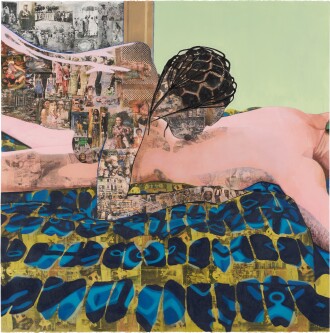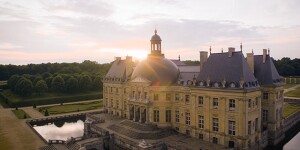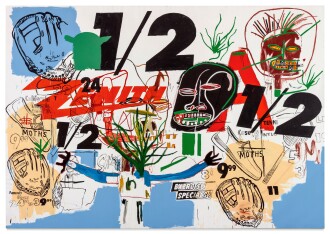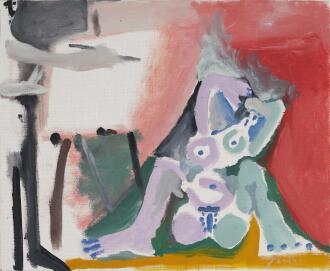T he New York Sales are always a major event on the global art scene, and this fall season’s auctions are no exception. Across five auctions, Sotheby’s presents an incredible array of artworks from the last two centuries. Now on public view through 15 May, the auctions features works by Cecily Brown, Jean-Michel Basquiat, Pablo Picasso, Claude Monet, Leonora Carrington and many more.
Read on for a look at 24 highlights from the hundreds of works coming to auction.

On Monday 13 May, The New York Sales begin with The Now Evening Auction, featuring the most exciting, cutting-edge works on the market.
Adrian Ghenie, ‘The Uncle’
The Enrapturing Narrative of Adrian Ghenie's Uncle | Expert Voices
Adrian Ghenie’s The Uncle vividly merges history and artistry, depicting a fugitive Nazi officer in a phantasmagoric swirl of colors which see the artist’s technical virtuosity at its absolute height. Ghenie’s interrogation of 20th-century history reaches a zenith in this piece, as figure and environment collapse into one another. Born under a Communist dictatorship, Ghenie rebels against oppression through his practice, infusing his portrayals of historic figures with unflinching candor and elements of slapstick comedy. The Uncle stands as a testament to Ghenie’s masterful handling of paint and philosophical depth, offering a cathartic exploration of humanity’s darkest chapters and a defiant challenge to authoritarian regimes.
Kerry James Marshall, ‘Vignette #6’
In Vignette #6, Kerry James Marshall redefines the Western canon with a revolutionary exploration of Black joy and presence. Drawing inspiration from Jean-Honoré Fragonard’s Fragonard’s cycle of Rococo paintings, “The Progress of Love” from 1771-73, Marshall’s “Vignettes” intervene in art history, centering Black figures in narratives previously excluded. Set against a decadent, bucolic backdrop, the painting challenges Eurocentric traditions in art, presenting Black affection as a radical presence. Through whimsical, romantic imagery and allegorical elements, Marshall creates an anachronistic masterpiece Vignette #6 stands as a pivotal work in Marshall’s ongoing mission to assert Black love and beauty in the art historical canon.
Cecily Brown, ‘Sirens and Shipwrecks and Bathers and the Band’
Cecily Brown’s Sirens and Shipwrecks and Bathers and the Band mesmerizes with its tempest of cobalt, cerulean and lapis blues. Inspired by Théodore Géricault’s Romantic masterpiece, The Raft of the Medusa, Brown’s colossal canvas immerses viewers in an oceanic narrative. Through sumptuous impasto, she conjures flesh-toned echoes and classical motifs, intertwining sensuality with vigorous gesture, captivating in its material presence and operatic scale. One of the most important artists in the arena of contemporary art, Brown redefines the medium of paint, creating pieces which hover between abstraction and figuration. Sirens and Shipwrecks and Bathers and the Band is a testament to her mastery at melding tradition with contemporaneity in a triumphant aesthetic alchemy.
Njideka Akunyili Crosby, ‘Thread’
Njideka Akunyili Crosby’s Thread from 2012 captures a tender moment of intimacy as the artist depicts herself kissing her husband’s back. Combining painting, draftsmanship and Xerox transfer, Akunyili Crosbyweaves personal photographs and Nigerian lifestyle magazines into a visual tapestry that embodies her uniquely hybrid brand of “Afropolitanism.” The work emerged during a critical period in Akunyili Crosby’s career, garnering attention at major exhibitions, such as the 2015 New Museum Triennial. Through her interdisciplinary practice, Akunyili Crosby extends the Western canon with her Nigerian heritage, articulating the complexities of her transcultural perspective. Thread invites viewers into her personal universe, exploring modern romance in a globalized society marked by diasporic exchange.
George Condo, ‘Conversations’
Conversations by George Condo, executed in 2012, stands as a pinnacle of the artist’s oeuvre, blending art historical references with contemporary aesthetics. Produced shortly after his major traveling retrospective, “George Condo: Mental States,” organized by the Hayward Gallery, London, and the New Museum, NY, the work showcases Condo’s mastery of what he has described as “psychological cubism.” Drawing from Cubist facture and portraiture traditions, Condo playfully subverts art historical tropes, infusing humor and absurdity into his compositions. Conversations teeters between representation and abstraction, inviting viewers into a realm where beauty and the grotesque coexist. Through varied perspectives, vibrant hues and multiformity, Condo orchestrates a visual chorale that reflects the complexities of the human psyche.

The marquee week continues on 13 May with The Contemporary Evening Auction, a showcase of post-war abstraction, Color Field Painting, Minimalism, Pop Art and more.
Francis Bacon, ‘Portrait of George Dyer Crouching’
Francis Bacon’s Primal Portrait of George Dyer Crouching | Sotheby's
Francis Bacon’s career-long exploration of human existence and lived experience found its pinnacle in his portraits of George Dyer, his
greatest love and muse. Executed during their intertwined life together at the height of their romance, Portrait of George Dyer Crouching is the first work in a poignant cycle of 10 monumental single-panel paintings from 1966-68. Dyer, a source of both ecstasy and despair for Bacon, embodies the artist’s vision of the human condition, becoming a conduit for the full range of tumult and drama that defined their love affair. In arguably one of his greatest portrayals of the human head, Bacon merges Dyer’s visage with his own, the head punctuated by Bacon’s singular, confrontational eye. This monumental work encapsulates Bacon’s technical mastery and the profound impact of his relationship with Dyer, immortalizing their love and turmoil on canvas.
Jean-Michel Basquiat & Andy Warhol, ‘Untitled’
Inside The Legendary Collaboration of Warhol and Basquiat's Untitled
-
 The New York SalesExploring Impressionism: From Pissarro to Monet and Beyond | An American Estate's Artistic Journey
The New York SalesExploring Impressionism: From Pissarro to Monet and Beyond | An American Estate's Artistic Journey -
 The New York SalesHow the Meier Family Collection Illuminates the Vibrant World of Nabis Revolutionary Art at Sotheby’s
The New York SalesHow the Meier Family Collection Illuminates the Vibrant World of Nabis Revolutionary Art at Sotheby’s -
 The New York SalesThe Cosmic Horizons of Fontana’s Concetto Spaziale, La fine di Dio
The New York SalesThe Cosmic Horizons of Fontana’s Concetto Spaziale, La fine di Dio
Executed in 1984, Untitled immortalizes the iconic collaboration between Andy Warhol and Jean-Michel Basquiat, whose work together epitomized the fusion of Pop Art and street sensibility. Introduced by dealer Bruno Bischofberger, the duo’s synergy produced a vivid canvas melding Warhol’s commercial iconography with Basquiat’s bold, Neo-Expressionist brushwork. Exhibited globally, the monumental work showcases the full scope of their cultural zeitgeist, from sports logos to urban decay. Their symbiotic relationship, marked by mutual inspiration and contrast, symbolized a dialogue between two distinct artistic generations and backgrounds, each effortlessly stoking the creativity of the other. Among the fullest and most accomplished of the artists’ corpus of “Collaboration” paintings, Untitled remains a testament to both artists’ transformative impact on 20th-century art.
Lucio Fontana, ‘Concetto spaziale, La fine di Dio’
The Cosmic Horizons of Fontana’s Concetto Spaziale, La fine di Dio
-
 The New York SalesWhat Does It Take To Be An Auctioneer? | Meet the Auctioneer Phyllis Kao
The New York SalesWhat Does It Take To Be An Auctioneer? | Meet the Auctioneer Phyllis Kao -
 ART HOUSE: The Collection of Chara SchreyerThe Evolution of Contemporary Art: The Visionary Collection of Chara Schreyer
ART HOUSE: The Collection of Chara SchreyerThe Evolution of Contemporary Art: The Visionary Collection of Chara Schreyer -
 Contemporary ArtCelebrating Culture and Friendship: The Salomón & Rosita Lerner Collection
Contemporary ArtCelebrating Culture and Friendship: The Salomón & Rosita Lerner Collection
Lucio Fontana’s 1964 masterpiece Concetto spaziale, La fine di Dio embodies the pinnacle of the artist’s revolutionary spatialist practice, epitomizing his groundbreaking exploration of space and light. Executed at the height of the Space Age, the canvas – one of only four rare examples in yellow – recalls the sun itself, densely pierced with a constellation of variegated punctures. Testament to Fontana’s radical reinvention of the picture plane, the canvas disrupts traditional notions of painting and ushers in a new era in art making. Fontana’s apertures are simultaneously visceral and ethereal, transcending the boundaries of painting and sculpture. Evoking themes of infinity, emptiness and the cosmos, Concetto spaziale, La fine di Dio stands as a paragon of Fontana’s visionary contribution to 20th-century art, offering a profound reflection on humanity’s place in the universe.
Richard Diebenkorn, ‘Ocean Park #126’
Color, Light, and Geometry: Decoding Diebenkorn's Ocean Park #126
Ocean Park #126 stands amongst the finest examples of Richard Diebenkorn’s “Ocean Park” series, reflecting the profound shift in his approach to color and form upon moving to Santa Monica, CA. Monumental and architectonic, this exceptional work balances rich cobalts, pale peaches and golden yellows within a delicate charcoal scaffolding. Each wash of color veils those beneath, imbuing the painting with a sense of place and process. Throughout his “Ocean Park” series – examples of which reside in institutional collections worldwide – Diebenkorn’s exploration of light and geometry testifies to the enduring power of painting and solidifies his status as a pioneer in American abstract art. Marrying color and light to transport the viewer to a luminous, abstract realm, Ocean Park #126 encapsulates the core of Diebenkorn’s artistic oeuvre, his genius as a colorist, and signature abstract vernacular.
Joan Mitchell, ‘Noon’
Joan Mitchell’s Noon embodies her compositional confidence, masterful handling of paint and the profundity of her encounters with the natural world. Executed circa 1969, Noon dates to the period just after Mitchell’s move to Vétheuil, a town once home to Claude Monet. Towering over 8 feet tall, Noon suffuses its viewer in Mitchell’s bold, variegated strokes, as lush impasto, structured forms and diaphanous drips of paint evoke the bucolic splendors of the French countryside. Mitchell’s canvases breathe life, celebrating nature’s essence with each brushstroke. Undoubtedly among the best examples from this celebrated period, Noon showcases an artist at the height of her creative powers, capturing the vivacity of her environs into a composition of extraordinary visual and emotional resonance.

14 May features over 300 works of contemporary art in The Contemporary Day Auction, including works sold to benefit the Walker Art Center and a group from Warhol’s ‘Toy Paintings.’
Martin Wong, ‘Liberty Mourning the Death of Her Sister - Beijing’
Martin Wong’s Liberty Mourning the Death of Her Sister - Beijing poignantly depicts the Statue of Liberty in deep sorrow, a metaphor for the Tiananmen Square Massacre of 4 June 1989. Born to Chinese immigrants in 1946, Wong felt deeply connected to the struggle for freedom. His meticulous portrayal, using bricks to symbolize confinement and labor, reflects his personal journey as a queer Chinese-American artist. Exhibited in 1990 after the tragic event, this masterpiece embodies Wong’s commitment to social realism and empathy, cementing its place as a powerful symbol of resilience in the face of adversity.
Gerhard Richter, ‘Abstraktes Bild’
In Gerhard Richter’s Abstraktes Bild (1983), layers of vibrant color and dynamic composition evoke a transcendent exploration of abstraction. Richter’s innovative use of the squeegee and meticulous layering creates a mesmerizing interplay of form and texture, reminiscent of landscape painting while transcending traditional boundaries. With echoes of Mark Rothko’s color exuberance and Yves Kline’s structural expressionism, Richter’s work is a pinnacle of artistic evolution. Through its dynamic surface, Abstraktes Bild invites viewers to explore the depths of perception and experience, embodying Richter’s unparalleled mastery of abstraction.
Morris Louis, ‘Split Spectrum’
Morris Louis’s Split Spectrum (1961) exemplifies his iconic “Stripe” paintings, merging warm and cool tones into vibrant ribbons of color. The painting, executed at the peak of Louis’s career, showcases his mastery of color and technique. Using a meticulous pouring and spreading process, Louis achieves symmetrical bands of intense hue, culminating in defined peaks. The painting’s precision and vibrancy reflect Louis’s innovative approach to abstraction, solidifying his status as a pioneering colorist.
Helen Frankenthaler, ‘Degas at 45’
A Family Legacy | The Barbara and Daniel Fendrick Collection at Sotheby’s
Helen Frankenthaler’s Degas at 45 (1974) captivates with its immersive landscape of vibrant color and texture, showcasing the artist’s mastery. From the collection of Washington, DC, gallerists Barbara and Daniel Fendrick, the painting resurfaces after almost 50 years, symbolizing a significant artistic relationship. Frankenthaler’s mature technique blends acrylics to create dynamic yet tranquil compositions, reflecting personal and professional growth. Evoking serene harmony amidst vibrant strokes, Degas at 45 embodies Frankenthaler’s exploration of emotional impressions through abstraction, inviting viewers into a meditative realm where chaos and peace coalesce.
Jonas Wood, ‘Clipping B3 (Succulent)’
Jonas Wood’s Clipping B3 (Succulent) showcases his signature blend of figuration and abstraction on a grand scale. With vivid pink and green succulent stems against a gray backdrop, the work evokes a domestic setting while challenging Renaissance ideals of perspective. Wood’s collage-like process, inspired by his grandfather’s collection and artists like Henri Matisse and Alexander Calder, infuses everyday objects with stylized forms. The painting, emblematic of Wood’s aesthetic, resonates with historical references yet maintains a resolutely modern appeal.
Exhibition installation images featuring a vinyl of Jean-Michel Basquiat photographed by Richard Corman. Vinyl photo © Richard Corman

The Modern Evening Auction, on 15 May, features late 19th- through mid-20th-century works of Impressionism, Surrealism, Cubism, Abstract Expressionism and beyond.
Claude Monet, ‘Meules à Giverny’
Why Claude Monet's Meules à Giverny is an Impressionist Masterpiece
-
 The New York SalesExploring Impressionism: From Pissarro to Monet and Beyond | An American Estate's Artistic Journey
The New York SalesExploring Impressionism: From Pissarro to Monet and Beyond | An American Estate's Artistic Journey -
 The New York SalesHow the Meier Family Collection Illuminates the Vibrant World of Nabis Revolutionary Art at Sotheby’s
The New York SalesHow the Meier Family Collection Illuminates the Vibrant World of Nabis Revolutionary Art at Sotheby’s -
 The New York SalesInside The Legendary Collaboration of Warhol and Basquiat's Untitled
The New York SalesInside The Legendary Collaboration of Warhol and Basquiat's Untitled
Claude Monet’s Meules à Giverny captures the essence of his bucolic Impressionism, portraying haystacks in the light-infused meadows near the site of his future water-lily pond. Completed in 1893, it marks the pinnacle of Monet’s study of Giverny’s landscape. Like the iconic series of haystacks executed from 1890-91, this masterpiece revisits one of the artist’s favored motifs, echoing Japanese simplicity in its focus and diverging from the stylistic interpretations of artists like Vincent van Gogh and Paul Gauguin. With a rich provenance, including ownership by Dwight Blaney and John Hay Whitney, the painting symbolizes the prosperity and harmony of rural life.
Leonora Carrington, ‘Les Distractions de Dagobert’
Unparalleled in its rich imagery, precise detail and explosive tonality, Les Distractions de Dagobert is the apotheosis of Carrington’s career and stands on its own as a masterpiece of 20th-century art – and one of the greatest contributions to the story of Surrealism. With its breathtaking rhapsody of allusions ranging from medieval European history to Irish and Mexican mythology, Carrington twists Renaissance aesthetic conventions with her famed wit. She painted this tour-de-force following a rebellious youth, brief sojourn with the Parisian Surrealist group and harrowing flight from war-torn Europe to Mexico City, where her creativity flourished at the heart of the city’s mid-century avant-garde. Impossible to fully untangle, Les Distractions de Dagobert invokes a profound sense of awe at humanity’s small place in a universe of endless potential.
Édouard Manet, ‘Vase de fleurs, roses et lilas’
In the final years of Édouard Manet’s life, visitors brought flowers to him, adorning his studio with vibrant bouquets. The masses of petals were rearranged in myriad ways, including in his preferred vessel of a tall, rectangular crystal vase with small white and gold decoration, as illustrated by this painting. Manet’s focus on still lifes in his later years reflected his belief in the genre’s significance, not only for its symbolic potential but also as a vehicle for artistic innovation. Influenced by earlier masters like Jean Siméon Chardin and Francisco de Zurbarán, Manet’s unique approach to still life defied convention, capturing the essence of life’s fleeting beauty. His legacy influenced artists like Paul Cézanne and Vincent van Gogh, shaping the trajectory of modern art. This particular work, Vase de fleurs, roses et lilas, bears a distinguished provenance, once owned by notable figures like Eugène Pertuiset and Jean-Baptiste Faure, reflecting its esteemed status in the realm of Impressionist art.
René Magritte, ‘Le Banquet’
René Magritte’s circa 1955-57 painting Le Banquet deftly challenges perception, presenting a serene and familiar landscape with a striking incongruity: a vermillion sun appears to set in front of a tree. Magritte’s exploration of the visible and invisible strikes at the heart of Surrealist notions of latent content. By making visible what’s expected to be hidden, Magritte unsettles viewers, inviting them to reconsider the fallibility of their perception. Pioneered in large part by Magritte, the paradigm shift in art from mimetic illusion to perceptual discovery shaped the trajectory of modern art and influenced generations of contemporary artists in his wake.
Alexander Calder, ‘Blue Moon’
Alexander Calder's Gong Mobiles and the Art of Performance | Expert Voices | Sotheby's
-
 Expert VoicesGustave Caillebotte, The Unknown Impressionist | Celebrating 150 Years of Impressionism at Sotheby's
Expert VoicesGustave Caillebotte, The Unknown Impressionist | Celebrating 150 Years of Impressionism at Sotheby's -
 The New York SalesAvery Singer’s Journey into the Digital Frontier | Expert Voices | Sotheby's
The New York SalesAvery Singer’s Journey into the Digital Frontier | Expert Voices | Sotheby's -
 The New York SalesFour Decades of the Abstract Impressionist Joan Mitchell | Expert Voices
The New York SalesFour Decades of the Abstract Impressionist Joan Mitchell | Expert Voices
Spanning a breathtaking 25 feet, Blue Moon of 1962 embodies the technical ingenuity and conceptual ambition that define Alexander Calder’s revolutionary sculptural oeuvre. As the mobile seamlessly pivots and oscillates, a central brass gong periodically collides with a wire mallet to imbue the surrounding space with sonorous reverberations. Suggesting infinite potential interactions between sound and motion, the present work represents the apex of Calder’s use of auditory elements to explore notions of chance and performance, both cornerstones of his practice. Gongs first emerged in Calder’s sculpture of the early 1930s and figured as an important element within his works throughout his career. Blue Moon is among the largest gong mobiles ever executed by Calder, surpassing the scale of those held in prestigious institutional collections such as the Metropolitan Museum of Art, NY, and the Art Institute of Chicago.

The New York Sales end on 16 May with a day auction drawing together a century of the very best modern paintings, drawings and sculpture across Europe and the Americas.
Maxfield Parrish, ‘Little Brook Farm (Sunup)’
Maxfield Parrish’s Little Brook Farm (Sunup) depicts a quaint farmhouse situated beside a reflective pond, enveloped on either side by dense trees. A narrow passageway at center welcomes the viewer into the composition, which is bathed in sunlight yet simultaneously permeated with soft clouds. The present work first appeared on the annual summer calendar for Brown & Bigelow Publishing Company, and is a superb example of Parrish’s enchanting approach to landscape subjects.
Pablo Picasso, ‘Le Peintre et son modèle’
For Pablo Picasso, the relationship between artist and model was a deeply historic and endlessly fertile source of creativity that remained constant throughout the many aesthetic evolutions of his career. Executed in 1965, Le Peintre et son modèle captures a charged moment just before an artist unleashes creative energy onto canvas. Picasso captures this sense of vitality through the juxtaposition of bare canvas with explosive hues of cinnabar red and the model’s overtly sensual pose.
Henri Matisse, ‘Jeune fille au chapeau de crin blanc’
Henri Matisse’s Jeune fille au chapeau de crin blanc is a superb example from the artist’s celebrated Nice period that encompasses many of the elements for which he is most well-known. This portrait of a striking woman, bedecked in a cloche hat, voluminous overcoat and a vibrant beaded necklace, illustrates Matisse’s keen attention to the ornaments of 20th-century fashion, jewelry and interior design, as well as his virtuosic use of color to play with the distinctions between volume and plane.
Pierre-Auguste Renoir, ‘La Baie d’Alger’
How the Meier Family Collection Illuminates the Vibrant World of Nabis Revolutionary Art at Sotheby’s
Coming from the Meier Family Collection, Pierre-Auguste Renoir’s landscape La Baie d’Alger vividly captures the Algerian light at midday. Executed in 1881, the work is an expression of one of the artist’s most transformative periods, in which he abandoned the Impressionist movement and instead followed in the footsteps of the Classical masters Eugène Delacroix and Jean-Auguste-Dominique Ingres through a grand tour of Italy and Africa. In the present work, he renders the landscape through a sumptuous mixture of textures, tints and shades.























































